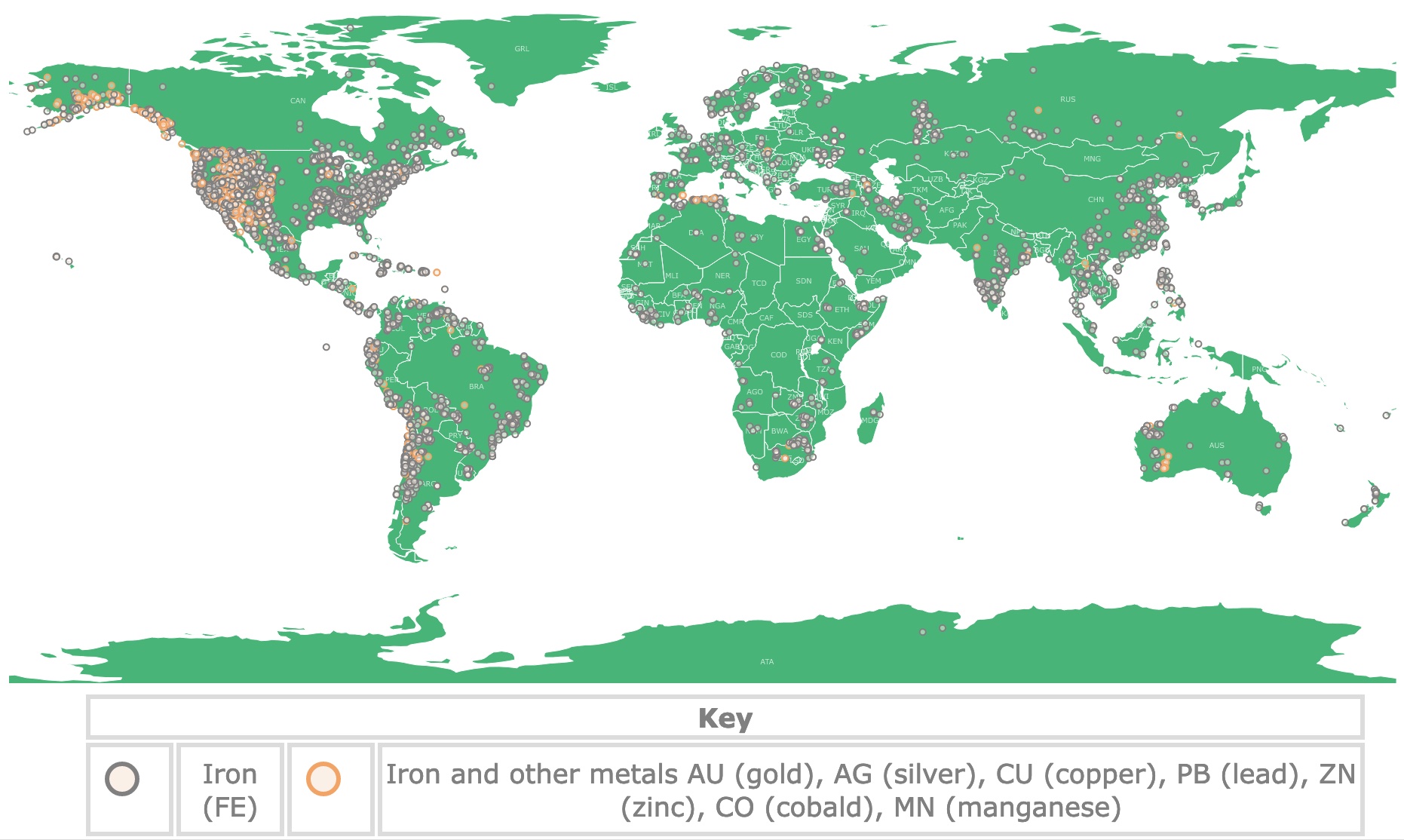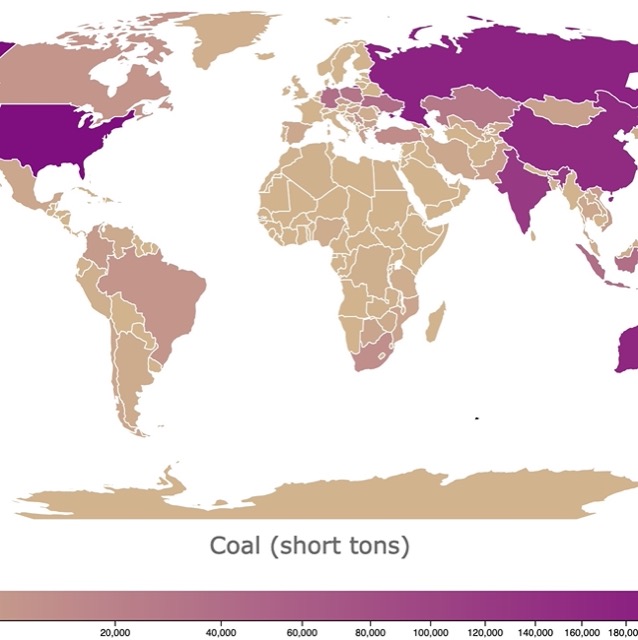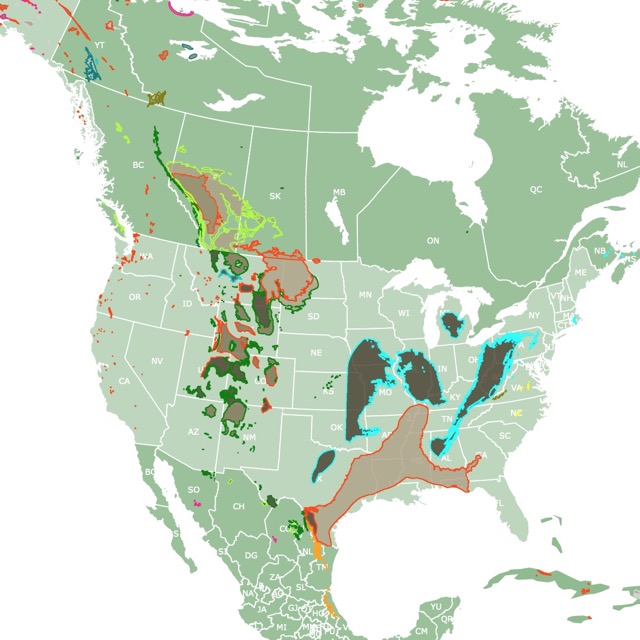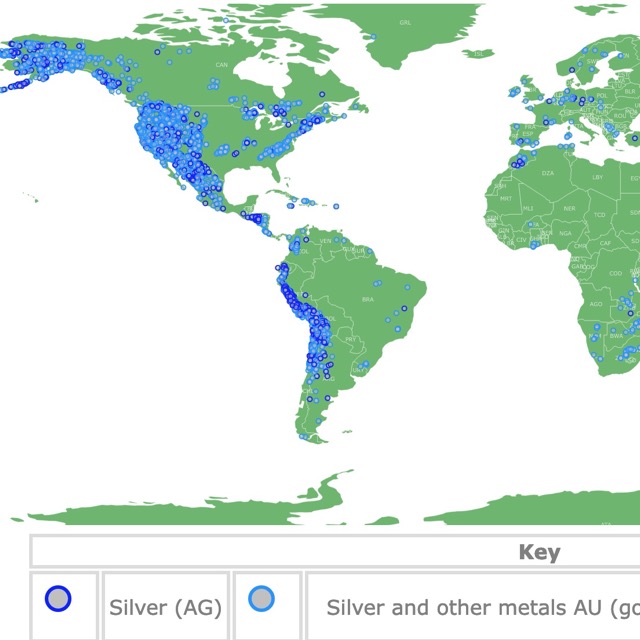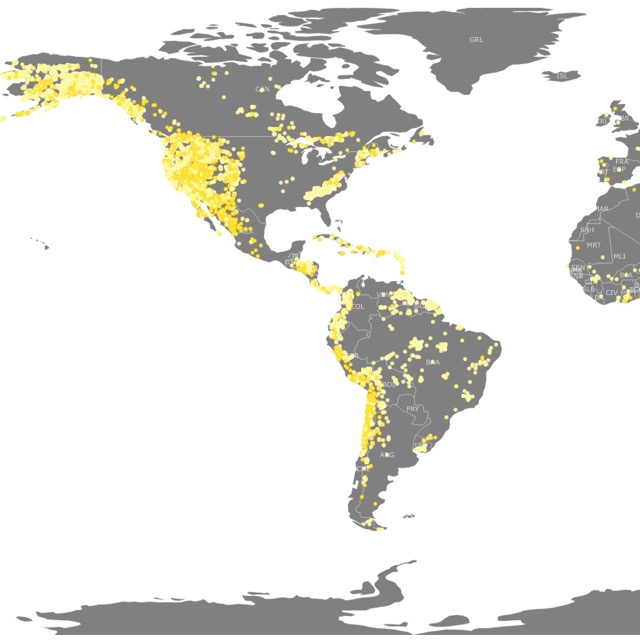Map of Iron Deposits Worldwide
This map depicts World Iron Deposits in gray. For more detail, hover over the map. To take a closer look, zoom in. For more information, scroll down.
| Key | |||
|---|---|---|---|
| Iron (FE) | Iron and other metals AU (gold), AG (silver), CU (copper), PB (lead), ZN (zinc), CO (cobald), MN (manganese) | ||
IRON
Iron is a shiny, grayish, brittle, hard metal, classified in Group 8 of the Periodic Table of Elements. The symbol of iron is Fe, from the Latin "ferrum".
In its pure form, iron is soft, malleable, and corrodes from exposure to humid air and warm temperatures.
Iron is easily worked, but it has a very high melting point of (2,800°F) 1,538°C.
Iron is about eight times heavier than water.
Iron is the fourth most common element in the Earth's crust. Furthermore, the Earth's core is believed to be composed of iron.
This liquid iron core is responsible for the Earth's magnetic field.
Iron is not just common on Earth; it is common in the sun and the stars. Iron is also a main component of some meteorites.
Ferromagnetism is a property of certain materials, such as iron. This is an unusual property that occurs in only a few substances.

It occurs in transition metals iron, nickel, cobalt, and their alloys, and alloys of rare-earth metals. It depends on a material's chemical makeup and crystalline structure.
If you think its time to invest in silver, gold, or other commodities, American Bullion can help. Precious Metals' purchasing power and wealth preservation have a proven record of accomplishment. To start today, Sing Up Here!
Iron's Biological Role
Iron is used in the human body by the protein hemoglobin. This protein in the blood carries oxygen from the lungs to all the cells in the body. Iron gives blood its red color.
The average human body contains 4 gr of iron. The lack of iron causes anemia; therefore, humans need 10 to 18 mg of iron each day.
Iron is a trace element necessary for photosynthesis. It is the limiting factor for phytoplankton growth in various sea areas. Algal blooms can be created by supplying iron to iron-deficient ocean waters. These blooms could be used to extract CO2 from the atmosphere! Source: Live Science.
You can buy an iron cube with Amazon. The Pure Metal Iron Cube is part of the Periodic Table Collection. Its beautiful looks and metal color are perfect for collectors. It is useful for experiments or just display. It includes the atomic number, chemical symbol, name, and density.
Iron's Uses
Iron is manly used to manufacture steel. Steel is an alloy of iron. Steel is harder and stronger than iron. This alloy is 80.6% iron, 0.4% carbon, 18% chromium, and 1% nickel.
Steel is used to make cars, trains, ships, tools, bridges, buildings, bicycle chains, and cutting tools, among other uses.
Stainless steel is very resistant to corrosion. It contains chromium and other metals like nickel, molybdenum, and titanium to increase its strength.
Stainless steel is used in cutlery, surgical instruments, jewelry, bearings, and architecture.
Steel is one of the world's most recycled products. About 60% of steel available for recycling goes back into making new steel.
Cast iron uses 3-5% carbon. It is used for pipes, valves, and pumps. It is not as hard as steel, but it is cheaper.
Learning about mining and metals does not make you richer, but buying and selling them will. Owning physical precious metals in a retirement account is a prudent and secure plan for your financial future. For more information go to American Bullion.
Iron Ore Origins
Deposits that contain metals in economically exploitable quantities are known as ores.
When metallic elements are found in nature in solid inorganic compounds, they are called minerals.
The most common iron-containing ore is haematite (Fe2O3), but iron is widely distributed in other minerals, such as magnetite (Fe3O4).
In smaller quantities, it can also be obtained from the minerals taconite, limonite, and siderite.
Most of the iron ore deposits formed 1.8 billion years ago. Back then, the oceans had abundant dissolved iron.
When the first photosynthetic organisms began releasing oxygen into the sea, this oxygen combined with iron to produce hematite and magnetite.
These iron minerals were deposited on the sea floor They formed what we know as the "banded iron formations."
They are known as banded because they have alternating bands of silica and shale. Source: Geology.com.
Most of these iron ore resources occur in banded iron formations of the Precambrian age. These formations occur on all continents.
Largest Iron Ore Deposits
Australia's Iron Ore Deposits
Australia has the largest reserves of iron ore worldwide. It is estimated it has 48 billion tonnes.
Most of the iron ore in Australia is extracted from Western Australia in the Pilbara district.
Australia is also the world's top iron ore producer due to its large deposits.
The iron content of these ores varies widely. Until recently, most deposits needed an average grade of more than 60% iron for mining to be commercially viable.
However, some deposits can now have iron grades between 56%-59% iron and be commercially viable. Source: Geoscience Australia.
Brazils's Iron Ore Deposits
Brazil has the second largest iron ores globally. It is estimated Brazil holds 29 billion tonnes of iron.
Carajás Mine based in the northern state of Pará is the world's largest iron ore mining operation.
Brazil's mining production is also second to Australia's.

Russia's Iron Ore Deposits
Russia holds about 25 billion tonnes of iron ore reserves.
Russia's large iron ores are in the Ural Mountains, Siberia, and the Kursk magnetic anomaly in the west.
The Kursk Magnetic Anomaly is recognized as the most significant magnetic anomaly on Earth. The anomaly is due to the large iron ores!
These large iron ores were used by the country's steelmaking industry when the country pursued industrialization.
Russia is the world's fifth-largest producer and Europe's largest iron producer.
China's Iron Ore Deposits
China has the fourth largest iron ore in the world. It holds approximately 20 billion tonnes.
China is also the third largest producer after Australia and Brazil.
Because of China's substantial population, sizeable industrial production, manufacturing, and construction boom, their iron production is not enough to fulfill the country's needs.
To supplement its steelmaking industry, China imports large quantities of iron. In 2021 China imported 70.1% of total imported iron ore worldwide. These imports were worth about US$173.6 billion. Source: World exports.
Ukraine's Iron Ore Deposits
Ukraine holds an estimated 6.5 billion tonnes of iron ore reserves.
The country's output exceeds its needs, so most of it is exported to China, Poland, and the Czech Republic. Source: Energy Business.
Resources for World Iron Deposits Map
The shapefiles with iron deposits are from U.S. Geological Survey mineral databases; MRDS and MAS/MILS Data Series 52 By: E.J. McFaul, G.T. Mason, W.B. Ferguson, and B. R. Lipin. It can be downloaded from MRDATA.
The Shapefiles with countries were downloaded from Natural Earth.
This map will be updated with new data! To receive updates on this and more nature maps, join my email list!!!!!!!
Made by Luz K. Molina with D3.js.
